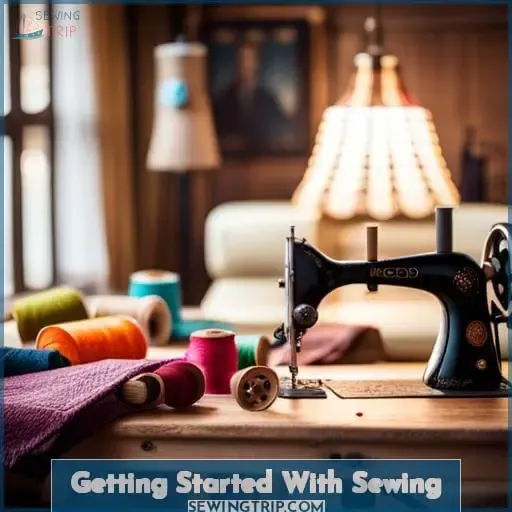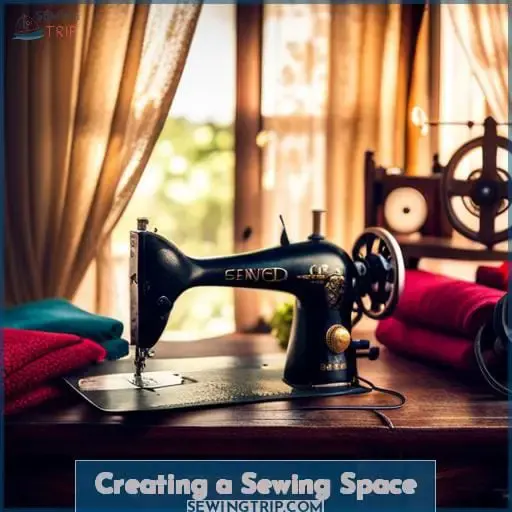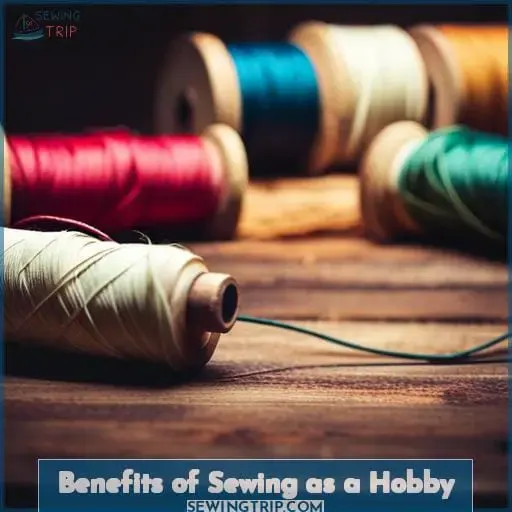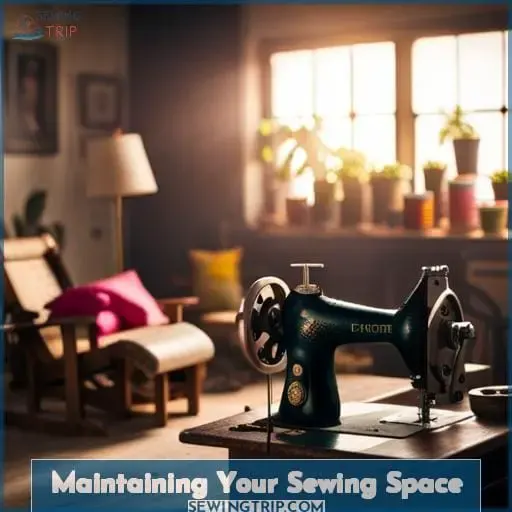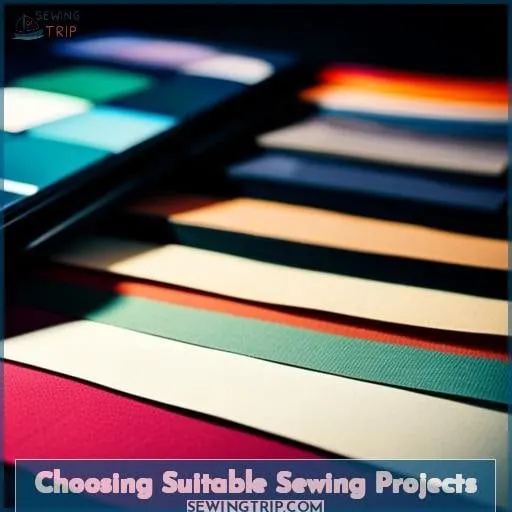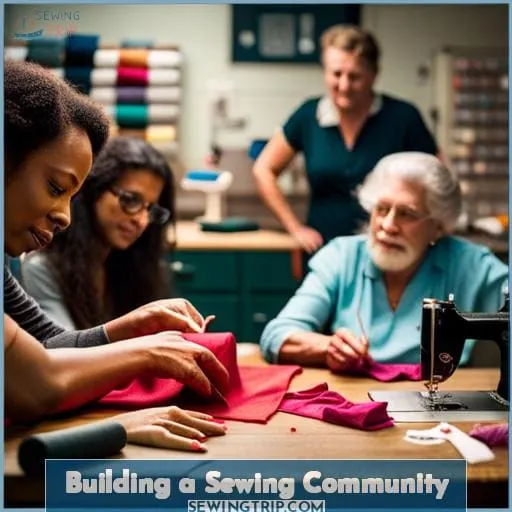This site is supported by our readers. We may earn a commission, at no cost to you, if you purchase through links.
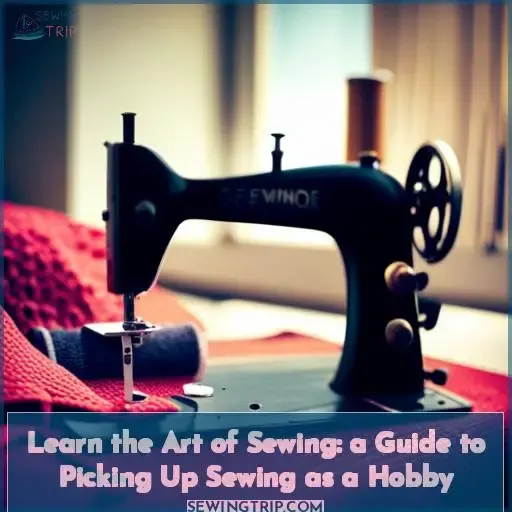 Embark on a journey of creativity and self-expression as you delve into the art of sewing.
Embark on a journey of creativity and self-expression as you delve into the art of sewing.
In this comprehensive guide, you will discover everything you need to know about picking up sewing as a hobby. From choosing the right materials to mastering essential techniques, this article will empower you with the knowledge and skills needed to become a skilled seamstress or tailor.
Get ready to unleash your inner designer and bring your creative visions to life through the timeless craft of sewing.
Table Of Contents
Key Takeaways
- Choose a suitable sewing machine based on budget and skill level.
- Gather essential sewing accessories and materials.
- Practice and master basic sewing techniques.
- Create a dedicated sewing space for maximum efficiency and productivity.
Getting Started With Sewing
To get started with sewing as a hobby, you need to invest in a suitable sewing machine based on your skill level and available space.
Make sure to gather essential accessories like needles, thread colors, fabric, scissors, and pins before starting any projects.
Learning basic sewing techniques such as straight-line stitching and seam finishing will lay the foundation for your journey into the world of sewing.
Invest in a Sewing Machine
To get started with sewing, you’ll need to invest in a suitable sewing machine.
When selecting a machine, consider your budget and skill level.
Look for machines that offer specialty features such as automatic needle threading or adjustable stitch length.
Once you have your machine, be sure to maintain it properly by cleaning regularly and following manufacturer’s guidelines for maintenance.
With the right sewing machine, you’ll be on your way to mastering this creative hobby in no time!
Gather Essential Sewing Supplies
You’ll need to gather essential sewing supplies before you start your sewing journey.
Sewing kit essentials include fabric, tools, and materials necessary for various projects.
Organizing notions such as needles, thread colors, scissors, pins are crucial for a smooth workflow.
When selecting fabrics, beginners should start with beginner-friendly patterns and consider thrifty sewing strategies like using scrap fabric from thrift stores or borrowing from friends/family.
Learn Basic Sewing Techniques
Start by familiarizing yourself with the basic sewing techniques that will lay the foundation for your sewing journey.
- Learn stitch variations to add dimension and texture to your projects.
- Develop precision skills for accurate cutting, measuring, and stitching.
- Master seam finishing techniques for clean and professional-looking seams.
Remember to practice these techniques regularly and explore advanced skills like applique mastery or decorative stitches as you progress in your sewing adventure while making sustainable fabric selections based on personal preferences.
Familiarize Yourself With Different Fabrics
As you delve further into the world of sewing, it’s important to familiarize yourself with different fabrics and their unique characteristics.
Fabric selection plays a crucial role in determining the success of your sewing projects. Explore texture variations, color palettes, and weaving techniques to create visually appealing garments.
Consider sustainability practices by choosing eco-friendly materials for a slow fashion approach.
Incorporate design tips from indie sewing patterns to build a versatile capsule wardrobe in your beautifully organized sewing room.
Master Design Tips
Once you have familiarized yourself with different fabrics, it’s time to master some design tips that will enhance the professional look of your sewing projects.
Seek design inspiration from fashion magazines or online platforms like Pinterest.
Experiment with embellishment techniques such as creative embroidery or pattern customization to add unique elements to your creations.
Explore textile manipulation methods like pleating or smocking for added texture and dimension.
These design tips will elevate your sewing projects and showcase your creativity and skill in a captivating way.
Creating a Sewing Space
When picking up sewing as a hobby, it’s important to create a dedicated space that meets your needs.
Choose an area with ample natural light or sufficient artificial lighting and plan the layout of your sewing room accordingly.
Make sure to make the sewing machine the focal point, personalize the space with inspiring decorations, and utilize storage solutions to keep everything organized and easily accessible.
Choose a Dedicated Sewing Space
Find a suitable area in your home to create a dedicated sewing space.
Ensure you have proper lighting essentials, such as natural light or sufficient artificial lighting, to avoid eye strain and ensure accurate stitching.
Set up an ergonomic workspace with a comfortable chair and spacious table for fabric layout and cutting.
Get creative with decor that inspires you, like favorite colors or framed fashion posters.
Implement functional storage solutions to keep your sewing room organized, allowing easy access to materials.
Add personal touches that make the space uniquely yours for an enjoyable sewing experience
Plan the Layout of Your Sewing Room
To plan the layout of your sewing room, consider how you can optimize the space for maximum efficiency and productivity.
Create a personalized workspace that reflects your style and inspires creativity.
Incorporate sewing room ergonomics to ensure comfort while working.
Explore creative wall decor options that add an artistic touch to your sewing space.
Implement efficient storage solutions to keep all your supplies organized and easily accessible.
Choose lighting solutions that provide adequate illumination for detailed work.
Make the Sewing Machine the Focal Point
Now, let’s focus on making the sewing machine the focal point of your sewing space.
First, prioritize maintenance essentials by regularly cleaning and servicing your machine.
Second, pay attention to workspace ergonomics to prevent discomfort or injury during long hours of sewing.
Additionally, get creative with machine decor by adding personal touches that inspire you.
Lastly, don’t forget about lighting considerations to enhance visibility while working on your projects.
Personalize Your Sewing Room
Choose a dedicated sewing space that reflects your personal style and inspires creativity.
Consider the layout of your room, making sure to place your sewing machine as the focal point.
Incorporate functional decor like labeled storage bins and open shelving for creative storage solutions.
Ensure ample lighting inspiration by either utilizing natural light or installing sufficient artificial lighting fixtures.
Add personal touches such as framed fashion posters or a corkboard for ideas to make the space truly yours.
Utilize Storage Solutions
Make sure to maximize the organization and efficiency of your sewing room by utilizing storage solutions.
Incorporate innovative containers, creative shelving, and organization hacks to optimize space and create functional layouts.
Invest in labeled bins for easy categorization of materials, use clear canisters or jars for small items, and consider open shelves or hanging organizers to make frequently used tools easily accessible.
With these storage solutions in place, you’ll have a well-organized sewing space that promotes productivity and creativity.
Benefits of Sewing as a Hobby
As you explore the world of sewing as a hobby, you’ll discover numerous benefits that make it an enjoyable and fulfilling pastime.
Firstly, sewing provides a unique form of stress relief, allowing you to immerse yourself in creativity and find calmness.
Additionally, by embracing sewing as a hobby, you actively contribute to creating a cleaner environment by reducing waste and avoiding fast fashion practices.
Lastly, engaging in regular sewing activities helps improve hand-eye coordination and cognitive development while providing the opportunity to tailor clothing for your perfect fit or save money through creating customized wardrobes at home.
Experience Stress Relief
By engaging in sewing as a hobby, you can experience stress relief and find a sense of relaxation and calm.
Mindful crafting allows you to focus your attention on the present moment, creating an opportunity for creative meditation.
The rhythmic motion of stitching promotes therapeutic stitches that soothe both the mind and body.
As you immerse yourself in the process of creating relaxing creations, such as garments or home decor items, you cultivate serenity through the art of sewing.
Contribute to a Cleaner, Greener World
Reduce waste and avoid fast fashion practices by sewing your own clothes.
By embracing sustainable fashion and eco-friendly practices, you can make a positive impact on the environment through your sewing hobby.
Incorporate upcycling techniques to repurpose old garments or fabric scraps, minimizing waste.
Practice green sewing habits such as using organic fabrics and natural dyes to reduce the environmental impact of textile production.
Your efforts in creating a cleaner, greener world are powerful and meaningful.
Enhance Hand-eye Coordination and Cognitive Development
Enhancing hand-eye coordination and cognitive development is one of the many benefits you can enjoy when taking up sewing as a hobby.
Sewing requires precision skills, where your hands and eyes must work together in harmony to manipulate the fabric, thread needles, and create intricate stitches.
This activity also promotes spatial awareness as you measure and cut fabric pieces accurately.
Furthermore, sewing enhances cognitive agility by stimulating problem-solving abilities while improving motor coordination through repetitive movements.
Enjoy the Ability to Tailor Clothing
When you take up sewing as a hobby, you’ll not only enhance your hand-eye coordination and cognitive development but also enjoy the ability to tailor clothing to your own unique style.
- Customization Benefits: You have the freedom to create garments that perfectly match your personal taste and preferences.
- Personalized Fit: Through precise measurements and alterations, you can achieve a fit that flatters your body shape.
- Alteration Mastery: Learn various tailoring techniques to modify existing clothes or resize them for an impeccable fit.
Clothing Adaptation is truly empowering!
Save Money by Creating a Customized Wardrobe
By sewing your own clothes, you can:
- Save money
- Create a wardrobe that’s uniquely tailored to your style and preferences
Sewing economics allows you to cut costs by eliminating the markup associated with retail prices. DIY fashion empowers you to express your personal style through custom clothing made specifically for you.
With a frugal wardrobe created through sewing, you have the mastery over creating high-quality garments without breaking the bank.
Maintaining Your Sewing Space
To maintain an organized and efficient sewing space, it’s important to keep your sewing room clean on a regular basis.
This includes:
- Putting away materials daily.
- Disposing of small fabric scraps.
- Decluttering monthly.
Additionally, consider donating or giving away any unused materials to friends who enjoy sewing.
Keep Your Sewing Room Clean
To ensure an organized and efficient sewing space, it’s essential to maintain cleanliness in your sewing room.
- Dispose of small fabric scraps regularly.
- Utilize storage solutions like labeled bins and open shelving.
- Put away materials at the end of each day.
- Perform monthly cleaning to keep your space tidy.
Consider Donating or Giving Away Unused Materials
If you find yourself with unused materials cluttering your sewing space, consider donating or giving them away to fellow sewers who can put them to good use. By doing so, you not only declutter your workspace but also have a positive sustainability impact by promoting material reuse and resource sharing within the sewing community.
Creative donations are a great way to engage in community outreach while fostering a sense of collaboration and empowerment among fellow sewers.
Benefits of Donating Unused Materials
| Benefit | Description |
|---|---|
| Sustainability Impact | Promotes material reuse and reduces waste |
| Community Outreach | Engages in meaningful interactions with other sewers |
| Resource Sharing | Encourages collaboration and knowledge exchange |
Create a Regular Cleaning Schedule
Maintain a neat and organized sewing space by establishing a regular cleaning schedule. This ensures that your workspace remains clutter-free, allowing for efficient organization and easy access to materials.
- Set aside time each week for standard cleanings.
- Utilize storage solutions like cabinets or woven baskets to keep everything easily accessible.
- Group small items efficiently with labeled storage bins, tackle boxes, or clear canisters/jars.
- Declutter monthly by disposing of any unnecessary materials or donating them to fellow sewing enthusiasts.
Organize Materials by Type
When organizing your sewing space, it’s important to categorize and store your materials by type in order to maintain a neat and efficient workspace.
Utilizing storage solutions such as cabinets, woven baskets, or labeled bins can help you keep everything easily accessible.
By implementing effective organization methods and sorting techniques, you can ensure that your fabrics are arranged in a way that allows for easy identification and retrieval during sewing projects.
Group Small Items Efficiently With Labeled Storage Bins
To efficiently maintain your sewing space, group small items together using labeled storage bins.
Compact solutions such as tackle boxes or clear canisters are ideal for miniature organizing.
Implement labeling techniques to easily identify the contents of each bin and optimize space in your sewing room.
Container systems allow you to categorize and store various notions, threads, buttons, and other accessories neatly, ensuring a clutter-free work area conducive to creativity and productivity.
Understanding Materials and Fabrics
When picking up sewing as a hobby, it’s essential to understand that stitching styles and techniques vary based on the type of fabric used.
As a beginner, it’s recommended to start with basic fabrics like cotton and gradually explore more complex materials such as leather or wool as your skills advance.
Additionally, venturing into softer and luxurious fabrics like chenille, silk, velvet can add an extra touch of elegance to your projects.
Remember that choosing the right fabric plays a crucial role in achieving the desired outcome for your sewing projects.
Know That Stitching Styles and Techniques Vary Based on Fabric Type
Understand how stitching styles and techniques vary based on the type of fabric you’re working with.
Different fabrics require specific techniques to ensure successful results. Each material has its own unique properties that influence the way it should be stitched.
From lightweight cotton to heavy canvas, each fabric demands different stitching nuances and skills.
The interplay between thread and fabric is crucial in achieving high-quality sewing outcomes across various textile-based projects.
Start With Basic Fabrics and Gradually Explore More Complex Ones
As you delve into the world of sewing, it’s important to start with basic fabrics and gradually explore more complex ones.
Begin by familiarizing yourself with cotton, a versatile and easy-to-work-with fabric.
As your skills advance, venture into advanced fabrics such as silk or velvet for a luxurious touch.
Explore fabric innovations and specialized materials that offer unique characteristics like stretchability or water resistance.
Embrace the journey of exploring textiles to expand your creative possibilities in sewing projects.
Venture Into Softer, Luxurious Fabrics
Now that you have started sewing with basic fabrics, it’s time to explore the world of softer, luxurious materials.
- Discover the exquisite feel and drape of silk fabric as you master its delicate nature.
- Learn the art of handling satin to create elegant garments that exude sophistication.
- Unlock velvet techniques and indulge in its plush texture for a touch of opulence in your creations.
- Embrace luxury textiles like chenille or crepe to elevate your sewing projects into works of art.
Consider the Importance of Fabric Choice for Desired Outcomes
When choosing fabrics for your sewing projects, it’s important to consider how the fabric choice will impact the desired outcome of your creations.
The weight of the fabric can affect how a garment drapes or holds its shape.
Color can have an impact on mood and style, while texture influences both aesthetics and comfort.
Pattern compatibility is crucial for cohesive designs.
Lastly, different fabrics may require specific sewing techniques to achieve optimal results.
Choosing Suitable Sewing Projects
When embarking on your sewing journey, it’s crucial to start with simple projects that will boost your confidence.
Choose projects that align with your personal interests and have practical uses in your everyday life.
As you gain more experience and skills, gradually progress to more complex items and explore a variety of patterns to expand your repertoire.
Start With Simple Projects to Boost Confidence
To boost your confidence in sewing, start with a few simple projects.
Begin by choosing beginner-friendly patterns that allow you to practice foundational skills and build stitches.
These crafts are designed to provide simple sewing wins, giving you a sense of accomplishment and motivating you to take on more challenging projects.
Progress to More Complex Items as Skills Improve
As you gain more experience and confidence in your sewing skills, it’s time to tackle more complex projects.
Progressing to advanced techniques and skill development allows for the creation of intricate and sophisticated items.
These mastery milestones showcase your progression as a skilled sewist.
Challenge yourself with complex creations that require precision stitching, intricate details, and advanced sewing techniques.
Pushing the boundaries of your abilities will lead to further growth in your sewing journey.
Explore a Variety of Patterns
As you progress in your sewing skills, it’s important to explore a variety of patterns to continue challenging yourself and expanding your repertoire.
Pattern exploration opens up a world of design diversity, offering creative options for personalization and style experimentation.
By trying out different patterns, you can discover new techniques and gain confidence in tackling more complex projects.
Embrace the endless possibilities that pattern exploration brings to your sewing journey.
Consider Practicality and Personal Interest When Selecting Projects
When choosing suitable sewing projects, it’s important to consider your personal interests and practicality.
Opt for practical project choices that align with your needs and preferences.
By crafting for use, you can create personalized creations that serve a purpose in your life.
It’s also essential to strike a balance between challenge and feasibility to keep yourself engaged and motivated throughout the process.
Choose projects that allow you to create meaningful creations while honing your sewing skills.
Building a Sewing Community
Building a sewing community is an essential aspect of picking up sewing as a hobby.
By joining local sewing clubs or online communities, you can connect with like-minded individuals who share your passion for sewing.
Engaging in discussions, sharing projects, and drawing inspiration from others not only fosters growth but also provides motivation, support, and a sense of camaraderie throughout your journey as a beginner sewist.
Join Local Sewing Clubs or Online Communities
To build a supportive network of fellow sewing enthusiasts, join local sewing clubs or online communities that foster collaboration and inspiration.
These communities offer a wealth of benefits, including:
- Drawing inspiration from others’ projects
- Sharing your progress and receiving valuable feedback
- Learning new techniques and skills together
- Building camaraderie with like-minded individuals
- Gaining motivation and support to continue improving your craft.
Engage in Discussions, Share Projects, and Draw Inspiration
Join local sewing clubs or online communities to connect with fellow enthusiasts, share your projects, and find inspiration for your sewing journey.
These communities provide a platform for:
- Project showcases
- Skill challenges
- DIY tips
- An inspiration exchange
Engage in discussions with like-minded individuals who can offer valuable insights and advice.
Community spotlights highlight exceptional work from members that can inspire you to push the boundaries of your own creativity.
Learn From Experienced Individuals Within the Community
Engage with experienced sewers in the community to learn valuable tips, tricks, and techniques for honing your sewing skills.
- Community Wisdom: Tap into the collective knowledge of seasoned sewers who’ve years of experience and insights to share.
- Skill Exchange: Participate in skill-sharing sessions where you can teach others what you’ve learned while also learning from their expertise.
- Project Showcases: Attend local sewing events or join online communities to showcase your projects and gain inspiration from others’ creative journeys.
Unlock a world of troubleshooting tips, inspirational journeys, and invaluable connections by immersing yourself in a vibrant sewing community.
Communities Offer Motivation, Support, and a Sense of Camaraderie
Immerse yourself in a sewing community to find motivation, support, and a sense of camaraderie as you embark on your sewing journey.
Community connections are essential for inspiration and growth in the world of sewing.
Engage with fellow sewists through project show-and-tell sessions, where you can showcase your work and receive valuable feedback.
Participate in skill swap sessions to learn new techniques from experienced members.
Joining sewing challenges will push you to expand your skills while fostering a supportive environment among like-minded individuals.
Frequently Asked Questions (FAQs)
Where can I find free sewing patterns as a beginner?
To find free sewing patterns as a beginner, explore online resources like Fabrics-Store.
They offer a range of beginner-friendly patterns for various garments, allowing you to practice your skills and unleash your creative potential without financial constraints.
How do I choose the right sewing machine for my skill level?
To choose the right sewing machine, assess your skill level.
Beginner machines offer basic features and are cost-effective, while advanced models provide more options for experienced sewers. Interestingly, 82% of hobbyists prefer electronic machines over mechanical ones for their versatility and ease of use.
What are some common sewing mistakes to avoid as a beginner?
To avoid common sewing mistakes as a beginner, ensure proper threading and tension on your machine.
Take time to measure accurately and cut fabric carefully.
Practice patience and precision in stitching techniques for professional-looking results.
How do I properly take care of my sewing machine?
To properly care for your sewing machine, regularly clean and oil it to ensure smooth operation. Avoid neglecting this task, as a poorly maintained machine could lead to catastrophic stitching failures that rival the eruption of Mount Vesuvius.
Are there any tips for sewing on difficult fabrics like stretchy materials or faux leather?
When sewing on difficult fabrics like stretchy materials or faux leather, use a ballpoint needle for better penetration.
Adjust your machine’s tension and stitch length accordingly.
Practice on scraps beforehand to ensure successful results.
Conclusion
To embark on the art of sewing as a hobby, you must first invest in a sewing machine and gather essential supplies.
Learn basic techniques and familiarize yourself with different fabrics to master the craft.
Creating a dedicated sewing space will enhance your experience, and maintaining it will ensure efficiency.
Sewing offers numerous benefits, including stress relief, cognitive development, and the ability to tailor clothing.
By choosing suitable projects and joining sewing communities, you can further enhance your skills and draw inspiration from others.
Start your sewing journey today and unleash your creativity.

